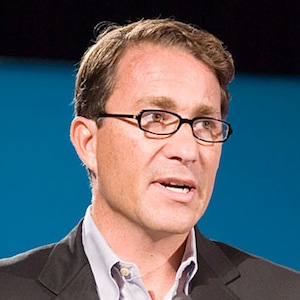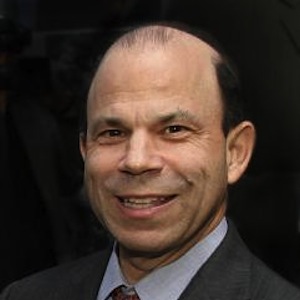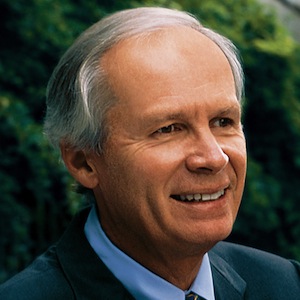Martin Nisenholtz: We are here on May 8 with John Huey and Martin Nisenholtz interviewing John Battelle through a Google Hangout. I’m going to ask the first question, John. Just so we’re clear, I have to disappear at four, so John will continue, if you have any time after 4:00. If you can go for just a few minutes, that would be great. We really need to have a good understanding of coming out of the .com bust, the scene in San Francisco. You and O’Reilly start this thing called Web 2.0. A bunch of so called Web 2.0 companies were founded way before, in the late ’90s and even into the early part of the decade. You don’t have the conference until 2004. Is Web 2.0 a rallying cry? The first theme was “The Web as Platform,” I think. Talk to us about Web 2.0, what that meant and what you were trying to achieve.
John Battelle: I think there was a cultural moment, after the .com crash, where there was a lot of sentiment in the air that this Internet thing was certainly important, but it was overhyped, under delivered, probably over capitalized and a lot of people lost a lot of money. In New York in particular the financial markets I think had a very negative view of the web as did a lot of the large media companies who had invested heavily in it, not seen a return. They’re quite honestly, I think, driven in part by a concern that their traditional models were going to be disrupted. So that there was some schadenfreude in. That didn’t work out. Also a sense that a lot of the things that were done in the latter half of the ’90s were ideas that didn’t have a lot of carry.
Web 2 really meant was if we take a platform that is open, that has a shared sense of values about how we connect to each other, how we share information, how we communicate, we can do some pretty remarkable things. A lot of forces had conspired over the course of two or three years from when the crash commenced to when that conference began.
That taken together meant that all of the sudden, some of the promise that had been, perhaps over hyped in the ’90s, it was possible to deliver on that promise now. There was a set of technologies that didn’t exist before and standards. You remember AJAX, but that was a new stack of technologies then.
The open source stack of technologies had become far more stable and probably most importantly, we had a broadband usage that had crossed 20 or 30 percent in developed markets. And was growing at a spike similar the spike we see now with mobile adoption.
We had just generally, while all of us were wringing our hands in the industry, no one stopped using the Internet. As a matter of fact, a lot more people, we got to a critical mass of people using the Internet and depending on it for a lot of things.
Probably the seminal Web 2 company, as you remarked, was one that started in 1998, and that was Google. Google was built from the ground up on this idea that the web is about connections between things. In the first instance those things were web pages, in the second instance they were people. Just like what we’re doing now on a Google platform.
I think that with Google came this realization that there was a new ecosystem that could be built on top of the value of the web as a platform. The sort of company that, to me, really was the namesake or the platform that allowed a lot of value was Google. Because it gave almost everyone an instant reason to derive value from the Internet, which was, I can instantly find what I need and go there.
That started a very important shift. Google went public the year that we started web 2.0.
Martin: Talk about the advertising markets at the same, kind of in the same era. The .com bust kills off the traditional display market, or brings it down very, very significantly. But within a couple of years, Google now has 9 billion of the 23 billion of advertising dollars spent on the web. I’m talking about 2005, now, 2004, 2005 time frame. Display has also come back, but there’s this underlying ad network ad tech thing going on, too. Can you talk about that?
John Battelle: Yeah, and I think that’s taken a good decade to truly develop. But we saw…History somewhat repeats itself, so in the late ’90s, we had lots and lots of ad networks, who strung together lots of different websites and made it possible to buy undifferentiated inventory at scale. Then there started to become the process of trying to differentiate that inventory that was deeply disrupted by the crash. But the people who started DoubleClick, the people who started a lot of the ad tech companies whose names we don’t remember because they didn’t make it through or they got folded into larger entities, those people didn’t go away. We see them back today in a very robust, extremely competitive new form, what we call programmatic ad tech or machine driven to data driven inventory buying.
At the same time, marketers demand value. I think, as an industry, we chose a set of advertising units for the Internet that became the standard, which, upon reflection, and John had mentioned earlier that you see things much more clearly when you can pull out of them and look back. We made a decision that the backbone of our advertising units that were not search related. Were relatively small and pretty easy to ignore from the point of view of a consumer, and not necessarily additive to the experience that people were having on the web. They were up at the top or over on the side and they weren’t necessarily adding value in some way to the experience people had on the web.
What happened with ad tech, I think, is that marketers started to see that inventory essentially as only as good as what it delivered in the direct response kind of way. That entire portion of the Internet, which was really driving a lot of the revenues for a lot of the companies, came into question in the last 10 years.
Right now, we’re in a very interesting transition period where, on the one hand, all of that sort of IAB standard units, all of that’s becoming liquid and commoditized to the point where it’s being valued pretty lowly, at a pretty low level.
At the same time, publishers are realizing that they can create new kinds of ad units and defend the inventory by using their own data and saying, “No, this is worth something if we’re going to make it worth something for you.”
There’s just a continuum there between the ad network model we saw in the late ’90s, which still exists today and is pretty big. The publishers who create premium inventory and who are working very hard to figure out how to deliver that to marketers in a way that adds value to the whole ecosystem to the publisher, to the reader, or consumer and to the marketer.
John Huey: John, you wrote, really, a pretty prescient book about Google, the ultimate Web 2.0 company. You wrote it kind of before they reached critical mass in some ways. But if you look today at where they are and you see that… I was looking at one set of numbers earlier today just a prediction for 2014, where they would get 20 billion in digital advertising versus three each for Yahoo, Microsoft and Facebook. We saw Sir Martin Sorrell say the other day that he would now spend more money with Google than with News Corp and that Google would be his biggest advertising spend. What’s next? Where do they go from here? In terms of share and dominance and if it’s not just a continued straight line up, what’s the disruptor around the corner? Is it social, is it Facebook, is it Twitter? What’s going to happen next?
John Battelle: I think the biggest war, if you just want to say in terms of dollars, has to be around how people consume and interact with video and entertainment. Because to me that’s a form of content that has what marketers want.
John Huey: Google has a pretty big piece of that today, too, right?
John Battelle: Google has a very big piece of that. Obviously, we’re streaming this to YouTube.
John Huey: Yeah, streaming it to YouTube through Google Hangout.
John Battelle: Google knows that. But what Google also knows is that the distribution mechanism for video is going to be any piece of glass that, you know, where video can be shown. Which means that you need access and distribution to whatever that form factor is where the video’s being shown. Hence Android, and the desire to have a broad reach into tablet, smartphone. Quite honestly, if you look at Google Glasses, the new platform from Google, that’s an attempt to define yet another piece of glass where there might be sight, sound and motion. Hopefully, not while you’re driving.
But, to me, the thing that can disrupt Google is someone who is a company who has the attention and the engagement of a consumer. That’s where the money’s going to go. And so, there are a lot of companies that have that beyond Google, but the truth is that Google’s done an extraordinary job of staying ahead of where that attention’s going to go.
When they’re not there, doing their level best to getting there. I think if you look at Google+ as a response to social, to me it’s more than that. It’s a conduit to what we’re doing. Google’s leveraging their extraordinary infrastructure to do something that’s super hard for any other company to do, which is allow people to spontaneously connect over video. That is super hard.
I’ve been thinking pretty hard about what Twitter’s doing. I see that as a potential significant disruptor as well. In that if people can start to have behaviors where they see Twitter as their window into determining how they’re going to spend their time. And inside of a Twitter card, you can just activate the video. If that video happens to be a competitive offering to Netflix, a competitive offering to Google or Apple TV, so be it.
That’s where that’s going in terms of Twitter, is I watch my activity stream. I see what my friends and connections are paying attention to. I see what’s trending and what’s hot and I connect to it and now I’m engaged. I consume, not just the content, but the advertising content. I think Twitter is to me a significant potential disruptor in this space, if you look at just the biggest buckets of money.
John Huey: You’ve already said video is where the money is going. Let’s talk for a minute about mobile and of course, everyone’s chasing the consumer where they meet video. But they’re also chasing the consumer on mobile where video and everything else meets. What’s at stake there and what are the choke points and just handicap that for me.
John Battelle: To me, the strategy that makes sense in mobile from the point of view of chasing the consumer is content goes everywhere. Good content is consumed in a mobile environment. We’re going to have, in the next three to five years, the infrastructure we discussed earlier, the programmatic sort of data driven infrastructure, feather into content in such a way that we’ll understand who’s consuming what in what context. Mobile gives you that context. Not just the context of what’s being consumed but where. With more data in the context of what else has been consumed in that context. Someone’s reading a review of a restaurant and we know that that person’s in a location near a suite of restaurants. That context will inform the kind of marketing that goes into that particular impression.
As will learnings from this kind of creative worked in the last hundred cases, but this kind of creative didn’t. Even to the point of this kind of creative worked in this context with this kind of a person and this kind of content. Where we’re getting to the point where a single impression can be valued on literally hundreds of data points.
When you get to mobile, it gives you a critical data point that’s almost as valuable. I’ve argued it’s more valuable, than the data point you had in search, which kicked off the Web 2 movement. That data point was, “Hey, I know what someone’s asking for.”
The data point in mobile is I know where somebody is. Then you add to that recipe all the other information you might know either about that person or about that location and what’s happened in that location. That all becomes information that can be traded in milliseconds and the right messaging can be delivered to that person at the point of consumption of the content.
That sounds pretty sci fi, but we’ve already built the infrastructure to execute on that and it’s called programmatic ad tech. It’s one of the reasons I think that business is the most important business we’re building right now.
John Huey: It all sounds pretty sci fi. If you go back to what you were writing about in “Wired Magazine” at the beginning, that all sounds pretty sci fi. By the way, you would be gratified to know how many people out of 60 interviews have taken it back to there. I would love to listen to you talk about this forever because it’s actually fascinating. If I were a business reporter doing a business story, we would keep going and I could go on and on and I wish we could. But for the purposes of this hangout, this is an oral history of the news business and the epic collision between the news business and technology.
Several things have become evident to us. One is the news business was always a bundle and actual news was always subsidized by support of other things that were around that news. Be it classified advertising, movie listings, whatever else people came to the newspaper for besides news about Iraq, Afghanistan, terrorism in Boston, politics.
All of that has become pretty thoroughly unbundled in the main on the web at least and there’s a decline in print readership and broadcast viewership of news. As one person put it, “The news business has always been the advertising business. They just don’t like to talk about the advertising business.”
That’s a very long preamble to a very short question which is you know as much about the state of the advertising business as anybody. Put that in context with the news business and how that’s going to go forward and how they will or won’t go forward together.
John Battelle: I have a lot of thoughts on that. We break the news business separately from what you might call “information services.” A lot of the, as you put it, bundling of the traditional news publication or news broadcast, there was a fair amount particularly in publications where the content that was created was created as attachment points for marketing. You’d have an automotive section in a newspaper where you’d have some editors write some interesting stories about new cars, or how to lease a car to gain financial advantage or whatever, but I’m going to inform a consumer about a broad advertising category. That would give the sales side of the business an opportunity to attach advertising to that.
“We’re going to cover entertainment more broadly so that we can get those movie listings and the big opening movie one page spreads,” and so on.
John Huey: It is the absence of advertising toward that kind of thing that has probably actually damaged the “news business” more than anything else.
John Battelle: I think we’re going to see digital publications where in fact brands are going to actually create the listing. Brands are going to actually create the service journalism and there will be deals struck where brands have the right to do that over a period of time. You see it happening in the magazine business. With some of the magazines you’ve been responsible for over the years, there are an awful lot of editorialists created by marketers. I would say the connection between value to the consumer and value back to the marketer in a print environment is harder to do than it is in a more real time digital environment.
I could imagine a time, and it’s already starting to happen, where brands essentially create that content as a service. You see brands who are already deep in the content creation business. There are obvious ones who come to mind like Red Bull where they say, “Why should we sponsor the X Games when we can just make them ourselves and we’ll be the creators of that entertainment content?”
John Huey: Or Coca Cola run their own Facebook program and it’s quite popular. The big argument in terms of…Leaving aside the issue of whether it’s a threat to democracy or whether there’s news or not news, how will the real news survive and thrive in this environment? Obviously, part of the answer is consumers will have to pay for high end quality news and that we’ve already seen that begun. Here’s the essential question. Is there a future for independent news and advertising to go forward together? That’s probably the big question.
John Battelle: I think it’s an uncertain future. I think there certainly will be some of it. I think the model is going to have to change and our cultural behaviors and honestly, our societal morals are going to have to change. Brands are in the midst of a very significant shift where they’re realizing that they can’t just have a corporate social responsibility program on the side or they can’t just buy a few ad placements in Sunday magazine news shows that no one watches because they’re trying to influence The Beltway.
John Huey: Those people watch each other to be fair. There are a few hundred people watching those things.
John Battelle: Yes there are. [laughs] It’s about that much. It’s a hard play on a reach and frequency basis to sell that. What I’m saying is that I believe that some brands are going to come to a realization that their core values of what they mean as a brand equals the underlying creation and delivery of high quality news. That’s what they mean as a brand.
That’s what “The New York Times” means as a brand. That’s what “Time Magazine” means as a brand. I think we’re going through a transition period and it’s a very difficult one if you’re in the business where brands on the other end of this transition are going to realize that’s what they mean as a brand and therefore they want to be known a delivering that value.
Does that mean that the masthead of the publication of the future that does actual hard, real, good news changes to the name of a brand? I would think maybe not, but I think it’s going to be very evident that that masthead is underwritten and brought to you by a brand that has permission to do that.
John Huey: It will become more like the Public Broadcasting model. I was going to use the word “underwritten” before you did. It’s really more about underwriting and not about reach or target marketing. It’s just that they decide to underwrite it because it has some brand value to them. Is that what you’re saying?
John Battelle: I think it will be even more tightly coupled than just underwriting. It becomes what the brand means.
John Huey: Underwritten, and edited, and partially created and driven by.
John Battelle: It literally is the role of that brand. Now I do not know that that is going to be the case with any number of the brands where there’s going to be a very clear conflict of interest. But then again if you look at a Proctor & Gamble, if you look at a GM or any one of this large brands and American Express, for 95 percent of hard news coverage, it doesn’t touch what they’re about. They will be able to create, I think, a news coverage vehicle that is essentially theirs that they underwrite with very transparent rules about how things are done if it affects their particular sector. There are models for this right now.
At Federated, we work with American Express to do a very scaled publication called “Open Forum” which is all about connecting value news as well as a lot of service for small business. Now that’s not a hard news publication, but it’s a model that I can see evolving towards supporting that.
Brands need to get to the point where they are transparent and honest about who they are in the world and can live with wrapping themselves in the banner of what it means to create and distribute real news.
You said, “Set aside the issue of what happens to democracy without this,” I hope we never do set that aside. There probably is an important conversation to be had about how we bridge this transition using the public will which for me translates into the model you discussed. Public will is public funding for essential pillars of democracy and that includes the news.
John Huey: We are having that discussion with a lot of people, but I just chose to focus this on advertising because you’re so in the thick of it. Let me ask you one other question that’s reverting a little bit more to your past life as a journalist and soothsayer. When you look at the super stacks and their roles in all of this…People talk about consolidations in various legacy industries and legacy industries no longer mean just print and journalism, there are a lot of tech legacy industries now.
Do you have any thoughts about their role in the creation and distribution and curation of news? I’m talking about the Amazons, the Apples. Not so much Microsoft although they’ve moved as far away from this as they can, but they are a legacy.
John Battelle: Not without spending a billion or so dollars in the process. [laughs]
John Huey: Billions.
John Battelle: I don’t want to go too far out on a limb here, but if there was brand or a set of brands that could do what I just described and had permission to do it, I would certainly list Google, Amazon, Apple and others as players who have the permission and the ability to underwrite, support, execute and distribute real news. Obviously, as major players in the economy and in our culture, that news would have to incorporate their impact on the world. But if they wanted to declare that they are truly brands that are transparent, trustworthy and have earned the permission to be engaged in consumer’s lives all day, every day, I can’t imagine a better way to do that than to wrap your brand in the banner of supporting super high quality news.
John Huey: It seems like from my point of view that Google would be the one intuitively the least likely, but actually maybe the most likely to be engaged in that for a lot of reasons.
John Battelle: For a lot of reasons. They are legacy. But remember, they’re legacies that are 15 years old. Apple’s 25 plus years old. But as digital media companies, they’re relatively new. As digital media companies Google really came out 10 years ago and 5 years ago got serious. Apple got serious about being a digital company really in 2007. And so, we’re talking about companies that I think are going to evolve to a point of view where they realize that probably someone’s going to have a brain storm and go, “My God, how do we maintain our credibility and trust and permission as a brand?”
But we could run an extraordinarily high quality news room. You know, cordon it off and set up the business rules around it and we can do that for about the cost of three super bowl ads. That’s a pretty damn good investment. We should do that.
It might sound crazy right now if someone were pitching it to Larry Page or to Tim Cook or to Jeff Bezos. But the one thing about those three companies is they’ve done some crazy stuff and it’s worked out.
John Huey: You sound like a guy with a business plan in your pocket.
John Battelle: [laughs] I’m just an advocate for ensuring that we have access to quality information that is without institutional bias. I think that there’s going to be a very big issue of trust with companies that hold so much of our personal data and with companies that have so much economic interest in ensuring that the world sees them in a certain light. I have a deeply optimistic view that brands generally are going to have to exist in a culture of transparency and trust in the future. To me, there is no greater way to do that than to underwrite, support and distribute the kind of quality news that is currently suffering from a significant business model disruption.

















